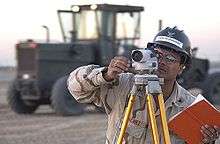Dumpy level

A dumpy level, builder's auto level, leveling instrument, or automatic level is an optical instrument used to establish or verify points in the same horizontal plane. It is used in surveying and building with a vertical staff to measure height differences and to transfer, measure and set heights.
Invention
In 1832, English civil engineer William Gravatt, who had worked with Marc Isambard Brunel and his son Isambard on the Thames Tunnel, was commissioned by Mr. H.R. Palmer to examine a scheme for the South Eastern Railway's route from London to Dover. Forced to use the then conventional Y level during the work, Gravatt devised the more transportable and easier to use dumpy level.[1][2]
Operation
The level instrument is set up on a tripod and, depending on the type, either roughly or accurately set to a leveled condition using footscrews (levelling screws). The operator looks through the eyepiece of the telescope while an assistant holds a tape measure or graduated staff vertical at the point under measurement. The instrument and staff are used to gather and/or transfer elevations (levels) during site surveys or building construction. Measurement generally starts from a benchmark with known height determined by a previous survey, or an arbitrary point with an assumed height.
Variants

The term dumpy level endures despite the evolution in design. A dumpy level is an older-style instrument that requires skill to set accurately. The instrument requires to be set level (see spirit level) in each quadrant to ensure it is accurate through a full 360° traverse. Some dumpy levels will have a bubble level intrinsic to their design which ensures an accurate level.
A variation on the dumpy and one that was often used by surveyors, where greater accuracy and error checking was required, is a tilting level. This instrument allows the telescope to be effectively flipped through 180°, without rotating the head. The telescope is hinged to one side of the instrument's axis; flipping it involves lifting to the other side of the central axis (thereby inverting the telescope). This action effectively cancels out any errors introduced by poor setup procedure or errors in the instrument's adjustment. As an example, the identical effect can be had with a standard builder's level by rotating it through 180° and comparing the difference between spirit level bubble positions.

An automatic level, self-levelling level, or builder's auto level includes an internal compensator mechanism (a swinging prism) that, when set close to level, automatically removes any remaining variation. This reduces the need to set the instrument truly level, as with a dumpy or tilting level. Self-levelling instruments are the preferred instrument on building sites, construction, and during surveying due to ease of use and rapid setup time.
A digital electronic level is also set level on a tripod and reads a bar-coded staff using electronic laser methods. The height of the staff where the level beam crosses the staff is shown on a digital display. This type of level removes interpolation of graduation by a person, thus removing a source of error and increasing accuracy. During night time, the dumpy level is used in conjunction with an auto cross laser for accurate scale readings.
Dumpy level in literature
In the first chapter of Thomas Hardy's 1887 novel The Woodlanders,[3] the narrator states, "He knew every subtle incline of the ten miles of ground between Abbot's Cernel and Sherton—the market town to which he journeyed—as accurately as any surveyor could have learnt it by a Dumpy level."
See also
References
- ↑ Saikia; et al. (30 Oct 2010). Surveying. PHI Learning. ISBN 8120339851.
- ↑ "William Gravatt". craig-telescope.co.uk. Retrieved 2012-05-31.
- ↑ Thomas Hardy, The Woodlanders
External links
- Dumpy level, from a surveying instrument collection.
- Checking a level
- Wye level (Y level)